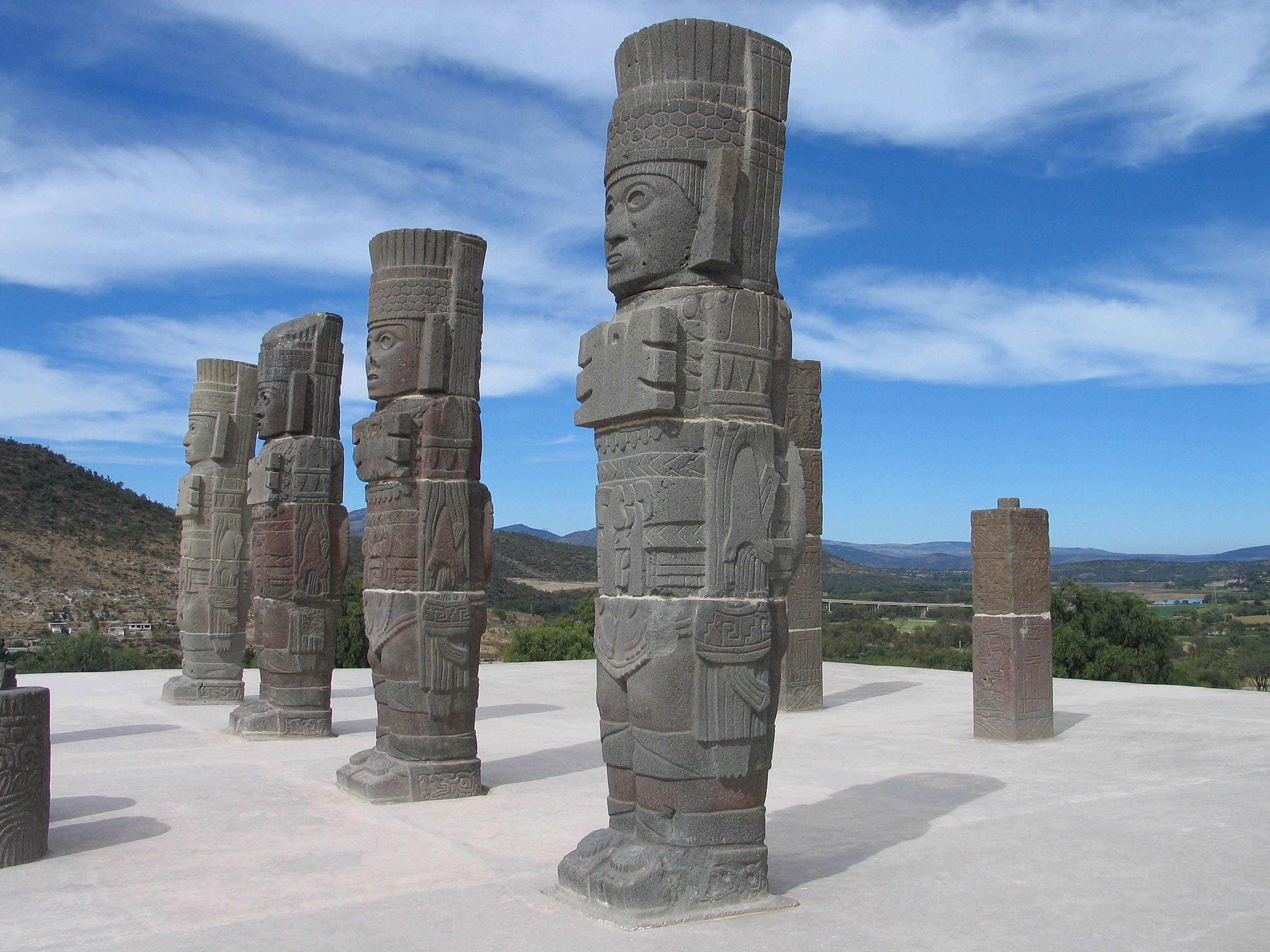All AP Art History Resources
Example Questions
Example Question #181 : Architecture
Incan architecture employed which of the following building techniques?
Post-and-lintel construction
Corbelling
Ashlar masonry
Lacunari
Ashlar masonry
Ashlar masonry is the term given to the finely beveled rocks fitted closely next to one another by Incan builders. Corbelling was used by Hindu architects to lend cavelike appearances to temples. Post-and-lintel construction was used in the building of Neolithic structures, including Stonehenge. Lacunari refers to the coffers used by Roman builders to lessen the weight of heavy ceilings.
Example Question #3 : Architecture Beyond European Artistic Traditions

Which feature of Monte Albán, pictured above, is meant to represent the victims of human sacrifice of the Zapotec civilization?
None of these
Distorted stone monuments of naked men called "Danzantes."
Relief sculpture carved into the stone walls of the Main Plaza.
Sacrificial altars used to store the hearts of the victims.
The Zapotec civilization did not participate in human sacrifice.
Distorted stone monuments of naked men called "Danzantes."
The Zapotec civilization used stone monuments depicting naked men with distorted posture and often mutilated genitals, called "Danzantes," or "Dancers," to represent their victims of human sacrifice. These stone monuments can be seen throughout the plazas of Monte Albán. Over 300 of these monuments have been found.
Image accessed at: https://commons.wikimedia.org/wiki/File:Panorama_of_Monte_Alban_from_the_South_Platform.jpg
Photograph by Matt Saunder
Example Question #373 : 3 D Art
The Anasazi were notable for constructing buildings in __________.
lake islands
desert plains
stone cliffs
swamplands
stone cliffs
The Anasazi are believed to have developed a unique culture in the American southwest around roughly the twelfth century B.C.E. The most notable aspect of Anasazi ruins and buildings is their location. In multiple sites in the Four Corners region, large stone palaces and other buildings are built into caves along stone cliffs, creating the look of a building that comes directly out of the stone walls.
Example Question #183 : Architecture
The Mayan civilization of Mesoamerica is perhaps best known for building which Pre-Columbian city, which in this day and age has become a popular tourist attraction?
Chichen Itza
Zocalo
Tlaloc
Queztalcoatl
Tenochtitlan
Chichen Itza
Chichen Itza, built and occupied between 600 and 1200 BCE, is a famous city built by the Mayans in what is today known as Yucatán, Southern Mexico. It is not completely known why Chichen Itza was abandoned, only that it remains in good condition to this day, and is a stunning example of Mayan architecture.
Example Question #371 : 3 D Art

The pyramids found alongside these stone monuments in what is now Hidalgo, Mexico, are examples of the architectural style of which pre-Columbian civilization of Mesoamerica?
None of these
The Inca civilization
The Aztec civilization
The Olmec civilization
The Toltec civilization
The Toltec civilization
The Toltec civilization dominated the area of Mexico that is now known as the state of Hidalgo in the early post-classic period of Mesoamerican chronology. The pyramids constructed in Tula, Hidalgo, Mexico, show an interesting similarity to Mayan architecture, though they are different enough as to be able to determine Toltec from Mayan architecture. What the similarities seem to hint at is that there was some kind of interaction between the Mayan and Toltec civilizations.
In addition, the Aztec peoples considered the Toltec civilization as their ancestors. Although little is known about the history of the Toltec civilization, the Aztecs wrote about them extensively. Unfortunately, it is not known if the accounts of the Aztecs are indeed historical, or simply fictional accounts of those whom they consider to be their ancestors.
Image accessed at: https://commons.wikimedia.org/wiki/File:Telamones_Tula.jpg
Photograph by Luidger
Example Question #181 : Architecture

The free-standing columns found in Hidalgo, Mexico, are a remnant of the architecture of which pre-Columbian civilization?
None of these
The Aztec civilization
The Olmec civilization
The Mayan civilization
The Toltec civilization
The Toltec civilization
The Toltec civilization dominated the area of Mexico that is now known as the state of Hidalgo in the early post-classic period of Mesoamerican chronology. The free-standing columns depicting Toltec warriors, also called Atlantean figures, are an example of the art and architecture of the Toltec civilization.
The Aztec people considered the Toltec civilization to be their ancestors. They saw these statues as representations of their Gods, such as Quetzalcoatl, and saw the Toltec architecture of Tula, Hidalgo as a divine space, like a city of Gods.Photograph by Luidger
Example Question #2 : Identifying Artists, Works, Or Schools Of Architecture Of The Americas

Monte Albán, estimated to have been built in 500BC, and located in what is now known as the state of Oaxaca in Mexico, was primarily occupied by which pre-Columbian civilization?
The Zapotec civilization
The Aztec civilization
The Olmec civilization
The Mayan civilization
The Inca civilization
The Zapotec civilization
Monte Albán was the cultural and political center of the Zapotec civilization for over one thousand years. The Zapotec civilization occupied the area now known as Oaxaca in Mexico. It was founded between 500 and 700BC, and later abandoned, over 1,000 years later. Although other Pre-Columbian civilizations discovered and potentially occupied the remains of Monte Albán after its abandonment, no civilization occupied it as their cultural and political center like the Zapotec civilization did.
Example Question #182 : Architecture

Monte Albán, pictured above, occupied from the year 500 BC to the year 850 AD, is a classic example of which style of architecture?
Ancient Greek
Mexican Baroque
Pre-Columbian
Mesopotamian
Ancient Egyptian
Pre-Columbian
Monte Albán, founded in large part by the Zapotec civilization, is a classic example of Pre-Columbian architecture. This means that it is was constructed in the Americas prior to European discovery and settlement. The city's stacked-pyramid appearance is a classic example of the most well-known style of Pre-Columbian, Mesoamerican architecture. In addition, the dates of its occupancy match up to those of Pre-Columbian civilizations.
Example Question #183 : Architecture
Mesoamerican architecture usually features the __________.
minaret
flying buttress
stepped pyramid
thatched roof
stepped pyramid
In Mayan, Toltec, and Aztec architecture, the chief building style was the large stepped pyramid, which allowed it to be climbed entirely. These pyramids were the center of any settlements, and were frequently utilized by the priest-kings of these cultures for ceremonial and administrative purposes. After centuries of neglect, these massive structures are usually the only elements of Mesoamerican architecture that remain.
Example Question #13 : Architecture Of The Americas
Mayan architecture was dominated by what kind of building?
The onion dome
The vaulted hall
The galleried temple
The minaret
The pyramid
The pyramid
All Mayan cities and temple structures revolved around the pyramid. Typically featuring steps to the top of the pyramid and terraces, the Mayas used the pyramid for temples, palaces, and most other important buildings. The use of the pyramid was highly influential for later Mesoamerican cultures, such as the Aztecs.
All AP Art History Resources




